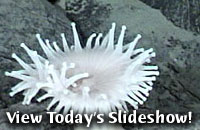|
|
April 27, 2001 By Amy Nevala Today we stood on top of a volcano - or rather, ROV Jason did. Through the vehicle’s remote cameras we explored the rocky summit of Knorr Seamount, a submarine volcano we mapped several days ago. This large seamount lies nearly mid-way between the Edmond and Kairei hydrothermal vent fields in the rift valley of the Central Indian Ridge. During a short CTD Tow-yo last night, the Plume Team identified a sizeable particle plume near one of several summit craters. Intrigued by the plume, this afternoon we lowered Jason and began searching the volcanic terrain for the vent source. Imagine draining the Indian Ocean and hiking on this volcano. You would wander in a giant, jumbled rock garden that stretches for miles. We saw three types of lava rock formations here, with names that describe their shapes: pillow-shaped lava; smooth sheet flows, and ropy lavas that twist like pulled taffy. Volcanologists -- scientists who study volcanoes -- generally agree that the shape of lava flows is determined by several factors: the speed of the flowing lava, its chemical composition, the slope that it flows over, and the temperature of the molten rock. Some of the lava glistened as Jason’s lights hit its glassy surfaces. This glass suggests that it is young lava, by geologic standards. “I’d guess the youngest lava here is probably at least 50 years old,” said Geologist Dan Fornari. “But it’s hard to tell just by looking at seafloor lava whether it is 100 years old or 1000 years old.” The rocky summit is largely a biological desert. An occasional fish zigzagging by the camera or a fat anemone provided a visual feast and elicited shouts from scientists like “hey, a fish!” One of the more comical and fascinating creatures we saw was the cherry-red shrimp that one biologist dubbed the “galloping lobster.” In reality this six-inch shrimp swims, although it resembles a horse galloping across a field as it moves its legs through the water. We will spend the next few hours tonight searching for a hydrothermal vent on Knorr Seamount. If we find one, we may stay for more sampling. Otherwise, we will return to the Edmond Vent Field for one last dive for sampling with ROV Jason.
|
||||||||||||||||||||||||||||||||||||||||||||||||||||||||||||||||||||||||||||||||||||||||||||||||||||||||||||||||
Mailing List | Feedback | Glossary | For Teachers | About Us | Contact
© 2010 Dive and Discover™. Dive and Discover™ is a registered trademark of
Woods
Hole Oceanographic Institution




